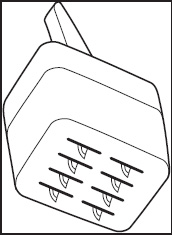Wet Cupping
Like bloodletting, wet cupping is a type of blood-extracting therapy. It works not only by extracting blood, but also by dissipating and regulating. The regulating effect is caused by two factors. First, the loss of blood serves as a stimulus to the bone marrow and initiates the formation of new erythrocytes as well as an increase in leukocytes. Second, the withdrawal of blood changes the quality of the blood, for example, by reducing viscosity and thereby improving its properties of flow, which has a positive effect on the tissue environment and corresponding biochemical processes. The result is a general stimulation of the entire organism.
Technique and Clinical Advice
Two methods exist for performing bloody cupping.
Method A
• In the first option, the location on the skin where blood is to be extracted is cleaned with a disinfectant and the scarificator (Fig. 6.1) is positioned firmly. The blades simultaneously produce several small incisions, 1 cm long and 4 mm deep. The suction cup is placed on top of these as in dry cupping, to suck the blood out of the scratch wounds.
Method B
• In the second version of wet cupping, locations that have just been treated with dry cupping are cleaned with a disinfectant and the cupping site is then scratched with the scarificator. After this, the suction cups are positioned on the same locations.
• Allow the cups to suck for 10-15 minutes.
• A suction cup sucks ca. 20 mL of blood. Depending on how much blood you want to extract, conclude the extraction of blood after the first cupping session or place the cups back again on the same locations.
• The amount of blood to be extracted depends for the most part on the patient’s pathologic condition, age, constitution, and state of health. Normally, you extract ca. 50–300 mL of blood, that is, you use 2–15 medium-sized suction cups.
• After cupping is finished, you swab the skin again with a disinfectant and dress it with ointment and a bandage. The patient should rest for up to 20 minutes afterwards.
• If required, wet cupping can be repeated in intervals of 4–8 weeks.

Fig. 6.1 Scarificator
 In wet cupping, disinfection, sterilization, and the use of disposable gloves must be a matter of course.
In wet cupping, disinfection, sterilization, and the use of disposable gloves must be a matter of course.
 For wet cupping, note: do not perform blood cupping above the vertebrae, on the front of the thorax, or in the vicinity of large veins.
For wet cupping, note: do not perform blood cupping above the vertebrae, on the front of the thorax, or in the vicinity of large veins.
• In standard cases, blood cupping is performed on sitting patients. Nevertheless, in very sensitive patients you can also perform cupping lying down, but this complicates the removal of the blood-filled cups.
• To determine whether a certain location on the skin may be treated with wet cupping, carry out a massage test. Lubricate the area well with oil and massage with a suction cup. If a few movements produce redness or extravasates, this indicates that wet cupping may be performed here.
Stay updated, free articles. Join our Telegram channel

Full access? Get Clinical Tree





